By Thomas Schlamme
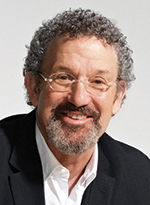
In this pivotal episode of The West Wing, there is a storm brewing in D.C.—both literally and figuratively.
President Bartlet has knowingly hidden his multiple sclerosis from his staff, the public and the press. Now, on this stormy night, wrestling with his own ghosts and guilt, our hero must face the cameras and the questions.
Despite his degenerative disease and the potential political fallout, the question at the center of the episode—the finale of Season 2, which originally aired May 16, 2001—is: "Will he run for reelection?"
The final sequence is set up beautifully by Aaron Sorkin's magnificent script. I also had the benefit of another brilliant writer, Mark Knopfler, as Dire Straits' "Brothers in Arms" underscores our montage. The song and storm build, along with the anticipation of Bartlet's decision.

In this shot, the President impulsively
decides to walk out of the Oval Office into
the rain, a baptism of sorts, to wash away
his previous sins. By initially shooting him through
the open door, we feel both the force of the rain
and the spirit of the recently departed Mrs. Landingham,
who served as his executive secretary.
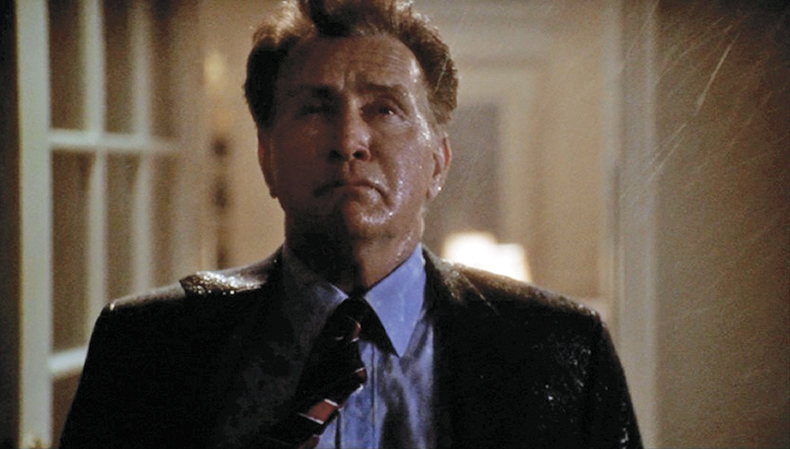
This was shot on our soundstage at
Warner Bros. where we had an incredible
20,000-square-foot interior set, as well as
an exterior portico that connected the West Wing
to the residence of the White House. What we did
not yet have was the ability to create a rainstorm
inside of the soundstage. In order to accomplish
this, we were forced to install a rather elaborate
and, unfortunately, rather expensive drainage system
to protect the interior portion of the set.
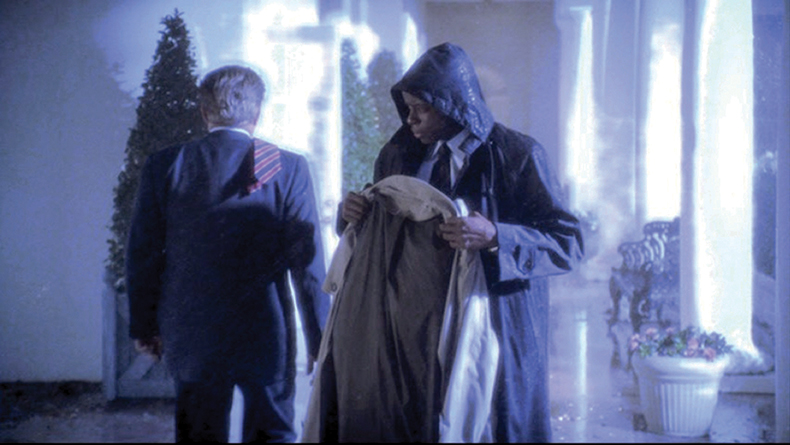
The first to Bartlet's side is Charlie. His loyal
"body man" offers the President a coat
to shield him from the storm, but Bartlet
refuses. Charlie lives in the shadow of his boss,
and in this high-contrast wide shot, he is wearing
a dark hood; we are thus unable to see his reaction
to Bartlet's rejection of the coat. Then cutting to a
close-up of the wonderful Dulé Hill, illuminated for
a brief second by the lightning effect, is all we need
to read Charlie's deep concern and loyalty.
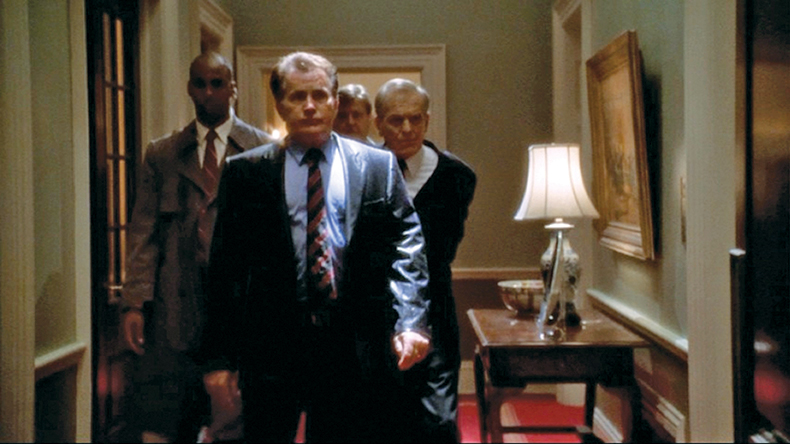
Stealing from every great Western, my
concept for this sequence was to see the
cowboys—the "brothers in arms"—joining
forces with our hero. In the first shot, the camera
finds Leo in his office putting on his coat, and he
takes us into one of our many hallways where he
meets the President, Charlie and the Secret Service.
This kind of choreography could never have
been accomplished without the wisdom and talent
of Jon Hutman, our production designer [for
the pilot], and Tom Del Ruth, our DP. Jon created
this gigantic labyrinth where our many different
worlds were all interconnected by a multitude of
hallways and doorways, all a bit wider than normal
to accommodate the Steadicam. Tom masterfully lit
each area differently to give them their own unique
character and devised an elaborate dimmer board
to allow us unlimited movement.
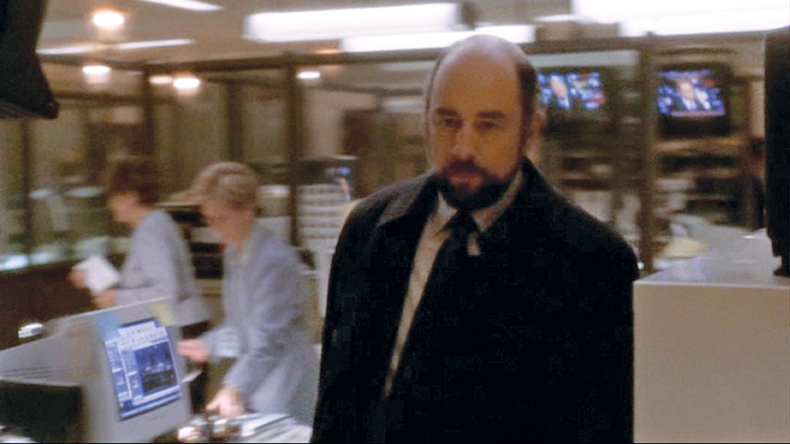
The second image starts with a wide shot
of the bullpen where, in the deep background,
Sam meets Josh as he exits his
office. As they head out of the room, Toby walks
into a close-up and takes us around a corner and
into our lobby. We lose Toby momentarily and
reveal Bartlet and his previous entourage heading
toward us (see #6). As Sam and Josh fall in behind
them, they now all walk into another hallway, where
Toby falls in step. Ready for battle, they march
forward together.

Since the pilot, I had been using the Steadicam
to accomplish three important
things: First, to create energy and movement
in a show with very dense dialog. Second, to
bring a sense of urgency—important information
can be exchanged on the move, scenes set on their
feet, illustrating that there is no time to waste in
this world. And third, to accomplish a seamless
transition from character to character, allowing the
audience to see the ensemble as a whole. These
two Steadicam shots illustrate the third reason
in the most dramatic way and help the audience
understand that these characters all serve at the
pleasure of the President.
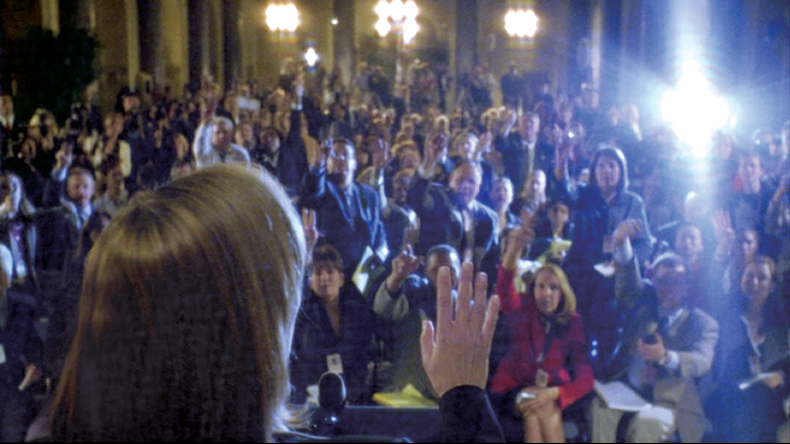
Meanwhile, back in town (maintaining
the Western motif), our dedicated press
secretary C.J. Cregg is keeping the restless
crowd at bay. The rest of the montage is all
shot on location in Washington, D.C. We needed to
find a room with grandeur and scale to shoot the
final press conference. The Classical Revival architectural
style of the Great Hall in the Department
of Commerce was perfect. A year later, though,
when we asked to film there again, the answer was
a resounding no. Not because of anything we did,
but because there was now a "new sheriff in town."
We never got quite as warm a reception from the
Bush White House as we had from the Clinton one.
Maybe it had something to do with the fact that
Martin [Sheen] had called the new President "a
white knuckle alcoholic."
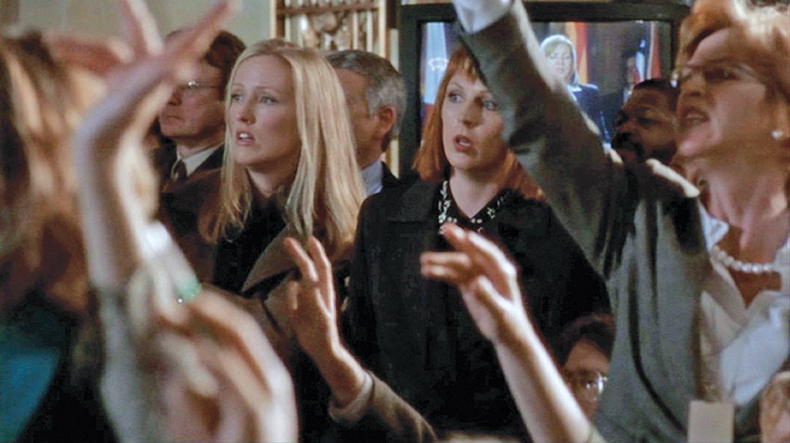
The visual language of The West Wing
was often as dense as the verbal language.
One traditional cutaway might tell
three different stories. In this particular cutaway,
we have a hostile press corps positioning to be
called on by the press secretary in the foreground.
In the midground, we see Donna and Margaret
arrive with a look of confusion and concern for the
President and their bosses. And in the deep background,
we see on a live monitor what everyone is
reacting to: C.J. being bombarded by questions.
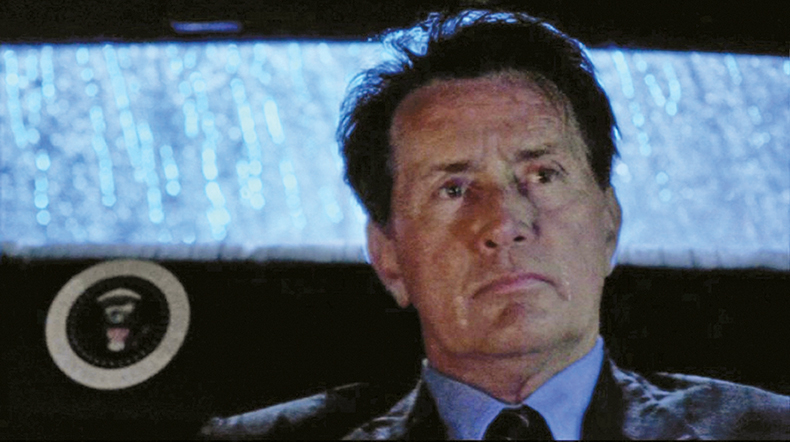
We only had minutes before the sun came
up to get a few very important shots of the
President traveling in his limo. These were
shot using a "poor man's process" in the Commerce
Dept. parking lot. Our wonderful DP in Washington,
D.C., Mike Mayers, who had no time to light this,
resorted to holding an inky and running back-andforth
along the side of the car, in the rain, to create
the passing lights. This was the end of three long
wet days and nights of shooting, and the exhaustion
shows on Martin's face in this close-up, which
fortunately helped illustrate the same feeling his
character was having.
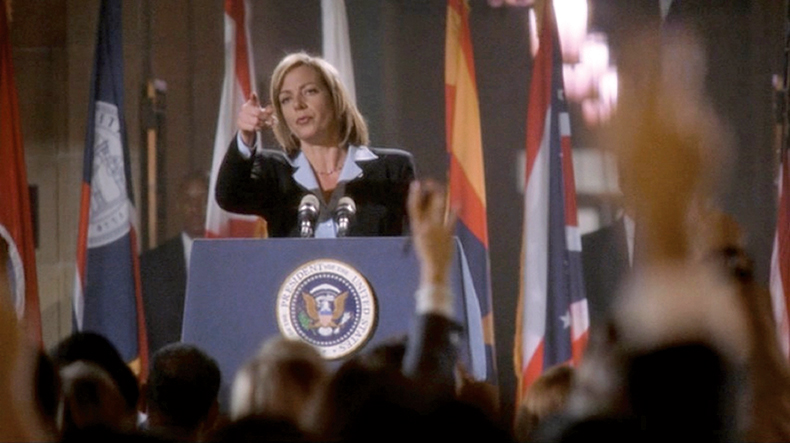
The juxtaposition of the next two shots
dramatizes what we often tried to accomplish
on this show. We were always
looking for ways to expose the personal side of our
characters by allowing the audience a peek behind
the curtain—to reveal these public figures as regular,
vulnerable human beings. Here in the first shot, we
see C.J. in full control, standing higher than her subjects,
patriotically framed by the colorful flags. She
is commanding the room from the podium emblazoned
with the Presidential seal. This is her professional
side, which is also captured by the television
cameras that were part of the press conference
within the show.

The reverse shot voyeuristically through
a doorway sees C.J. with the lights glaring
in her eyes, silhouetted by the flags
which now appear to imprison her, standing
behind the empty, unimpressive podium. All of
these elements help reveal the personal side of
C.J., at this moment lonely, exposed and vulnerable.
This view is only captured by our cameras,
and not the cameras at the press briefing.
These two shots give the viewer a very different
impression of the exact same moment.
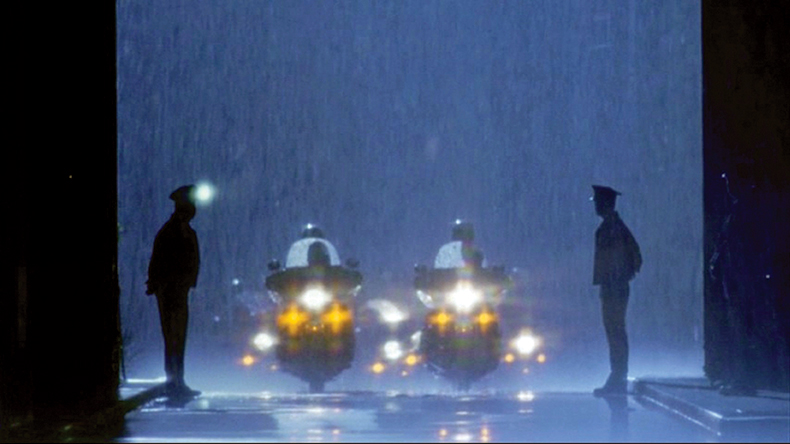
We mostly used wider elements on the
show. However, in this episode, I wanted
to do a series of long-lens compression
shots, referencing classic Western imagery.
Inspired by the very familiar shot of the gang on
horseback appearing on the horizon (as seen in
Ford's The Searchers, Peckinpah's The Wild Bunch,
George Roy Hill's Butch Cassidy and the Sundance
Kid, etc.), we created a dramatic entrance for the
motorcade in the back of the Department of
Commerce.
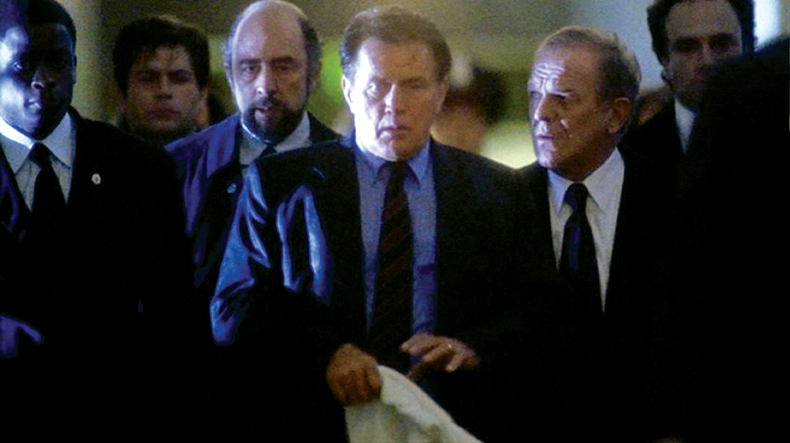
In another shot (as seen in Leone's A
Fistful of Dollars, Eastwood's Pale Rider
and Kasdan's Wyatt Earp), we borrowed
an equally familiar image-panning up from determined
feet to the faces of our heroes on the
way to the gunfight. Instead of dust, boots and
cowboys, we had shiny floors, Florsheims and
politicians.
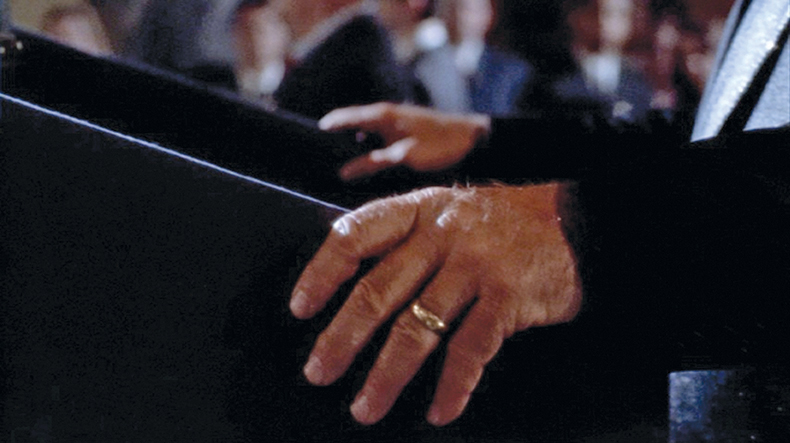
The final shots of this episode might be
my favorite of the whole series. The setup
is that, ever since President Bartlet was a
child, whenever he had decided to do something,
he would stick his hands in his pockets, look away
and smile. So we needed a shot of that very action
which culminates with his hands at the podium. I
wanted it to be choreographed in one 180-degree,
slow Steadicam move. Compared to some of the
other shots we had accomplished, this was not
incredibly difficult. But what makes it so special
to me is the very last frame (#15). I had asked the
grips to build a flagpole in the courtyard so that an
American flag would be visible from the secondstory
window.
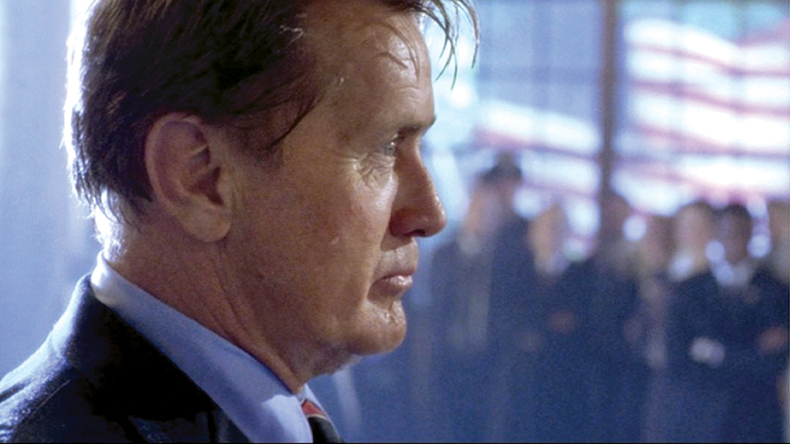
We had rain towers hitting it and a
Ritter fan blowing it. My hope was that
we might catch a glimpse of it in the
background. But miraculously, on the take when
the Steadicam move was just perfect, the flag fluttered
exactly at the last moment of the shot—filling
the whole background frame. I have always felt
it symbolized our enormous good fortune to work
on this show. As Thomas Jefferson said, "I am a
great believer in luck and I find the harder I work
the more I have of it."